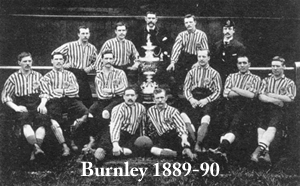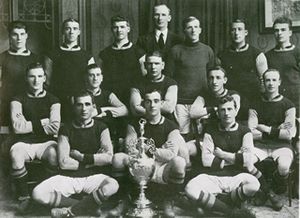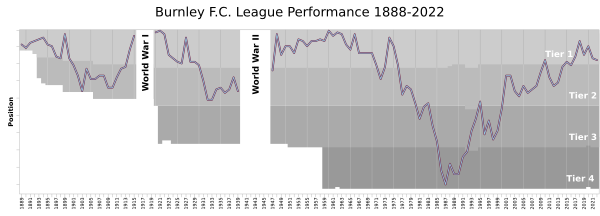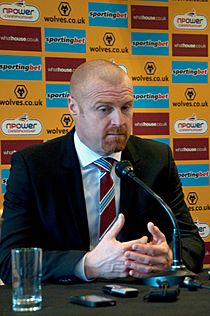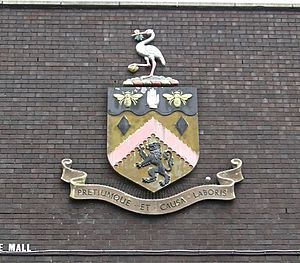Burnley F.C. facts for kids
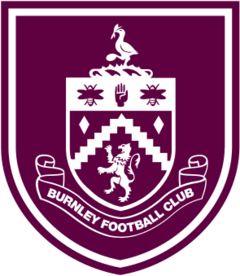 |
||||
| Full name | Burnley Football Club | |||
|---|---|---|---|---|
| Nickname(s) | The Clarets | |||
| Founded | 18 May 1882 | |||
| Ground | Turf Moor | |||
| Capacity | 21,944 | |||
| Owner | ALK Capital LLC | |||
| Chairman | Alan Pace | |||
| Head coach | Scott Parker | |||
| League | Premier League | |||
| 2018–19 | Premier League, 15th of 20 | |||
|
||||
Burnley Football Club is a professional football team from Burnley, Lancashire, England. They play in the Premier League, which is the top football league in England.
The club started in 1882 and became one of the first professional teams in 1883. They helped convince the Football Association to allow players to be paid. Burnley was one of the 12 founding members of the English Football League in 1888, which was the world's first football league.
Burnley is one of only five teams to have won all four professional English football divisions. They have won the English league title twice, in 1921 and 1960. They also won the FA Cup once in 1914 and the FA Community Shield twice. In the 1920–21 season, Burnley set an English record by going 30 league matches without losing.
From the 1950s to the 1970s, Burnley was known for its great youth and scouting system. They were one of the first clubs to build a special training ground. Most of the players who won the 1960 league title came from the club's own youth academy. At that time, Burnley was one of the smallest towns to have a top-tier English champion.
The team has played their home games at Turf Moor since 1883. Their nickname is "The Clarets," and their team colours, claret and blue, were chosen in 1910. The club's badge is based on the town of Burnley's coat of arms. Burnley has a big rivalry with Blackburn Rovers, and their matches are called the East Lancashire derby.
The player with the most appearances for Burnley is Jerry Dawson, who played 569 games. The club's top goalscorer is George Beel with 188 goals.
Contents
Club History
Early Days and First Wins (1882–1946)
Burnley Football Club was started on May 18, 1882, by members of a rugby team called Burnley Rovers. They decided to switch to football because it was becoming very popular. The club won its first trophy, the Dr Dean's Cup, in 1883. Later that year, they became a professional club and signed many skilled Scottish players.
At first, Burnley did not join the Football Association (FA) because the FA did not allow professional players. But in 1885, the FA changed its rules, and Burnley played in the FA Cup for the first time in 1885–86. In 1886, their home ground, Turf Moor, was the first professional football ground visited by a member of the royal family, Prince Albert Victor.
Burnley was one of the twelve clubs that started the English Football League in 1888. This was the world's first football league. In their second league match, William Tait scored the first ever league hat-trick for Burnley. In 1890, they won their first Lancashire Senior Cup by beating their rivals, Blackburn Rovers.
Burnley was moved down to the Second Division in 1897. But they won the division the very next season and were promoted back to the top league. They were relegated again in 1900. The club faced money problems in the early 1900s, even finishing last in 1903, but they were allowed to stay in the league.
In 1909, Harry Windle became chairman, and the club's money situation improved. In 1910, Burnley changed their team colours from green to claret and blue, which they still use today. That same year, John Haworth became the new manager. In 1913, the team was promoted to the top league. The next season, Burnley won their first major trophy, the FA Cup, by beating Liverpool 1–0 in the final. Tommy Boyle was the first captain to receive the trophy from a king, King George V.
Burnley finished second in the league in 1920, and then won their first ever First Division championship in 1921. They lost their first three games but then went 30 league matches without losing, which was an English record at the time. Nine seasons later, the team was relegated to the Second Division. They struggled in the second tier for many years.
A Golden Era (1946–1976)
In 1947, after World War II, Burnley was promoted to the First Division and reached the FA Cup final, but lost. Their defence was so strong that season, they were called "The Iron Curtain."
Alan Brown, a former Burnley captain, became manager in 1954, and Bob Lord became chairman in 1955. Under them, the club became very modern. Burnley was one of the first clubs to build a special training ground at Gawthorpe. They were also famous for finding and developing many talented young players through their youth system.
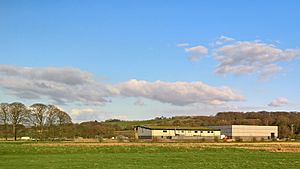
In 1958, former player Harry Potts became manager. His team was built around captain Jimmy Adamson and star player Jimmy McIlroy. Potts often used a 4–4–2 formation and a style of play where all players helped each other.
Burnley won their second First Division title in 1960. They only reached the top of the league on the very last day of the season. The team was very special because most of the players had come through Burnley's own youth academy. The town of Burnley, with only 80,000 people, became one of the smallest towns to have an English top-tier champion.
The next season, Burnley played in a European competition for the first time. They beat Reims but lost to Hamburger SV in the quarter-finals. In 1962, they finished second in the league and reached the FA Cup final, but lost to Tottenham Hotspur.
In 1961, the rule about how much players could be paid was removed. This meant that clubs from smaller towns like Burnley found it harder to compete with richer clubs. Key players like McIlroy and Adamson left or retired, which affected the team. However, Burnley stayed in the First Division for the rest of the 1960s.
Adamson became manager in 1970, but the team was relegated in 1971. They won the Second Division title in 1973 and then won the 1973 FA Charity Shield against Manchester City. In 1975, Burnley suffered a big FA Cup upset when Wimbledon, a much smaller team, beat them 1–0. Adamson left in 1976, and Burnley was relegated from the First Division again that year.
Tough Times and Comeback (1976–2020)
The team was relegated to the Third Division for the first time in 1980. Under manager Brian Miller, they won the Third Division title in 1982 and returned to the second tier, but only for one year. Burnley kept changing managers, trying to find success. In 1985, they were relegated to the Fourth Division for the first time.
In 1987, Burnley almost dropped out of the professional football leagues entirely. They avoided relegation to the non-League Football Conference on the very last day of the season by winning their match.
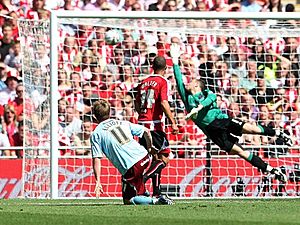
In 1988, Burnley played Wolverhampton Wanderers in the final of the Associate Members' Cup but lost. However, 80,000 people watched the match, which was a record for two teams from the fourth tier.
Burnley won the Fourth Division title in 1992 under manager Jimmy Mullen. By winning this title, Burnley became only the second club to win all four professional English football divisions. They were promoted to the second tier again in 1994 but were relegated after one season. In 1998, they avoided relegation to the fourth tier on the last day.
Under manager Stan Ternent, Burnley finished second in 2000 and were promoted to the second tier. In 2002, the club faced serious money problems. In 2009, with Owen Coyle as manager, Burnley was promoted to the Premier League after 33 years away from the top flight. They beat Sheffield United in the Championship play-off final. Burnley also reached the semi-final of the League Cup that season.
Being promoted meant Burnley was one of the smallest towns to have a Premier League club. The team started well, winning their first four home games. However, Coyle left in January 2010, and Burnley was relegated after just one season.
Sean Dyche became manager in October 2012. In his first full season, Dyche guided Burnley back to the Premier League in 2014, even with a small budget. They were relegated after one season but won the Championship title in 2016, going 23 league games unbeaten. In 2017, the club built a new training centre called Barnfield.
Burnley finished seventh in the Premier League in 2018, which meant they qualified for the 2018–19 UEFA Europa League and returned to European football after 51 years. They did not reach the group stage, losing to Olympiacos.
New Owners (2020–Present)
In December 2020, an American investment company called ALK Capital bought 84% of Burnley for £170 million. This was the first time the club was not owned by local business people and supporters.
In 2022, Burnley was relegated back to the Championship. In June 2022, Vincent Kompany from Belgium became Burnley's manager, the first non-British manager for the club. He rebuilt the team with many young and foreign players and introduced an attacking style of play. Burnley won promotion back to the Premier League in 2023 with seven games left, a Championship record. They then won the Championship title by beating Blackburn Rovers.
In the 2024 season, Burnley was relegated from the Premier League again. Soon after, Kompany left to manage Bayern Munich.
Burnley won promotion back to the top league right away under Scott Parker. They ended the 2025 season with a club record 33-match unbeaten run. The team only let in 16 goals in 46 matches, which is the best defensive record in English league history. They also kept a record 30 clean sheets (games without letting in a goal). Burnley became the first team to get over 100 points in the Championship twice (101 points in 2023 and 100 in 2025). Despite these achievements, they finished second behind Leeds United on goal difference, becoming the first team in English football history to earn 100 points without winning the title.
Team Kits and Colours
|
|
| Burnley's kit in the first Football League season (1888–89). The actual kit had long sleeves. |
In their early years, Burnley used many different kit designs and colours. For the first eight years, they mostly wore blue and white. Before the 1890–91 season, they wore all-blue shirts, but changed to all-white during the season. They also wore amber and black, and pink and white stripes. From 1900 to 1910, they wore all-green jerseys.
In 1910, Burnley changed their colours to claret and blue. These have been their main colours for most of their history, except for a time in the 1930s and during World War II when they wore white shirts. After the war, in 1946, the club officially registered claret and blue again. This change in colours also led to their nickname, "The Clarets." Before that, they were called "The Turfites" or "The Moorites."
Since 1975, different companies have made Burnley's kits. Since 1982, their shirts have also featured sponsors' names. The first sponsor was Poco Homes. The longest-running shirt sponsor was Endsleigh Insurance, from 1988 to 1998. In 2017, the mobile game Golf Clash became the first sponsor to appear on the left sleeve of Burnley's shirts.
Club Badge
Burnley's shirts first had a badge in December 1887. It was the coat of arms of the Prince of Wales, to remember Prince Albert Victor's visit to Turf Moor. This royal badge was worn regularly until 1895 and again for the 1914 FA Cup final.
In 1935, the town of Burnley's coat of arms appeared on the club's shirts for the first time. It returned for the 1947 FA Cup final and became a regular feature after their 1960 league title win. From 1969 to 1979, the home kits featured a stylish "BFC" design.
In 1972, Burnley held a competition to design a new badge that could be copyrighted. The winning design featured two lions, two red roses, a bee, a weaving shuttle, a knight's helmet, and a hand. This badge was officially adopted in 1973. It was used on away kits from 1976 and on home kits from 1979. In 1983, it was replaced by a simple "B.F.C." design, but the older badge was brought back in 1987.
In 2009, to celebrate 50 years since the 1960 title, the club brought back the town's coat of arms from the 1960s. The Latin motto was replaced with "Burnley Football Club" the next year. In 2023, the badge elements were changed to white and placed on a claret shield for the 2024–25 home kit.
The club's current badge is based on the town of Burnley's coat of arms. The stork at the top represents the Starkie family, who were important in the area. It holds a Lacy knot, which refers to the de Lacy family who owned Burnley long ago. The stork stands on a hill with cotton plants, showing the town's history with cotton. The hand below means "Hold to the Truth," from the Towneley family motto. The two bees show the town's hard work, the lion represents royalty, and the chevron symbolises the River Brun, which flows through Burnley.
Home Stadium
Burnley has played their home games at Turf Moor since February 1883. Before that, they played at Calder Vale. Turf Moor has been used for sports since at least 1843, when Burnley Cricket Club moved there. Both clubs have stayed there ever since. Only Preston North End has used their stadium, Deepdale, for longer.
The ground first had only a pitch, and the first main stand was built in 1885. In 1888, Burnley won their first league match at Turf Moor 4–1 against Bolton Wanderers. Fred Poland scored the first league goal at the stadium. The capacity of Turf Moor was increased to 50,000 in the 1910s.
Turf Moor hosted its only FA Cup semi-final in 1922. Five years later, it hosted its only full international match between England and Wales. From the 1940s to the 1960s, crowds at the stadium were usually between 20,000 and 35,000. Burnley's record attendance for a single match was 54,775 in 1924, for an FA Cup game against Huddersfield Town.
The field at Turf Moor used to have a slope until 1974, when it was made flat. In the mid-1990s, the stadium was updated. The standing areas were replaced with all-seater stands, meaning everyone had a seat. In 2019, the club built new sections for disabled fans. Turf Moor now holds 21,944 people and has four main stands.
Fans and Rivalries
Supporters
Burnley's fans mostly come from East Lancashire and West Yorkshire. The club has a very strong following for the size of its town, with around 21,000 fans attending Premier League games in a town of about 78,000 people.
Burnley's first supporters' club started in 1932. Many other fan groups have been created since then, both in the UK and other countries. Burnley fans have a long-standing friendship with supporters of the Dutch team Helmond Sport since the 1990s. Fans from both clubs often travel to visit each other's matches. For the 2022–23 and 2023–24 seasons, Helmond Sport even used claret and blue away kits to honour Burnley.
A popular song sung by fans since the 1970s is "No Nay Never," which is based on "The Wild Rover" and includes words to tease their main rivals, Blackburn Rovers.
Famous Burnley fans include football expert Jimmy Hogan, journalist Alastair Campbell, and cricketer James Anderson. Even King Charles III is a supporter of the club. In 2019, Burnley fan Scott Cunliffe received an award from UEFA for his work promoting diversity and inclusion in football. He ran to every away Premier League ground during the 2018–19 season and raised over £55,000 for charity.
A unique drink served at home matches since World War I is "Béné & Hot." It's the French liqueur Bénédictine mixed with hot water. Soldiers from the East Lancashire Regiment learned about the drink in France during the war and brought it back home. Burnley Football Club is one of the biggest sellers of Bénédictine in the world, and Turf Moor is the only British football ground that sells it.
Rivalries
Football started in Burnley in the early 1880s, and by 1883, the town had over 20 teams. One of Burnley's first rivals was Burnley Union Star, a team from the north of the town. Their rivalry was strongest in 1887 during the Lancashire Cup. Union Star later disbanded in 1891.
Burnley's main rivals are Blackburn Rovers. Their matches are called the East Lancashire derby because both clubs are from that region. They are also known as the "Cotton Mills derby" because both towns were famous for their textile mills. Both clubs were founding members of the Football League and have won the First Division and the FA Cup. The two clubs are only 14 miles apart and have a long history of rivalry, with their first competitive match in 1888. Burnley has won more games against Blackburn (45 wins to Blackburn's 41).
Burnley's closest geographic rivals are actually Accrington Stanley, but they have never played in the same league level, so there isn't a strong rivalry between them.
Other rivalries include nearby clubs like Blackpool, Bolton Wanderers, and Preston North End. Burnley also has a rivalry with West Yorkshire teams Bradford City and Leeds United.
Players
First-team squad
|
|
Out on loan
|
Academy
Club Management
Football Management Team
| Position | Name |
|---|---|
| Head coach | Scott Parker |
| Assistant coach | Henrik Jensen |
| Coaching staff | Jack Cork Jonathan Hill Mike Jackson Connor King Kersten Kuhl |
Source:
Managers Who Won Titles
Harry Bradshaw, who was born in Burnley, was the club's first manager in 1894. He was the first to win a league title for the club, leading them to the top of the Second Division in 1898. John Haworth was the first manager to win a major trophy, the FA Cup in 1914. Under Haworth, Burnley also became champions of England for the first time in 1921.
Harry Potts led the club to its second First Division title in 1960. Other managers who won league titles for Burnley include Jimmy Adamson (Second Division in 1973), Brian Miller (Third Division in 1982), Jimmy Mullen (Fourth Division in 1992), Sean Dyche (Championship in 2016), and Vincent Kompany (Championship in 2023).
Club Owners
Since it started until 2020, Burnley was run by local business people and supporters. In December 2020, an American investment company called ALK Capital bought most of Burnley. Alan Pace, a managing partner at ALK Capital, became the club's chairman.
In May 2023, J. J. Watt, a famous American football player, and his wife, Kealia Watt, became new smaller investors. The YouTube group Dude Perfect also became investors later that year. In July 2025, ALK Capital bought a majority share in the Spanish team Espanyol, making Burnley part of a group of clubs owned by the same company.
Board of Directors
| Position | Name |
|---|---|
| Chairman | Alan Pace |
| Members | Dave Checketts Antonio Dávila Stuart Hunt Mike Smith Vlad Torgovnik |
Source:
Club Chairmen Over Time
|
|
Club Honours
Burnley was the second team, and is one of only five teams, to have won all four professional divisions of English football. The other teams are Wolverhampton Wanderers, Preston North End, Sheffield United, and Portsmouth.
Here are some of the trophies Burnley has won:
League Titles
- First Division (Top League)
- Champions: 1920–21, 1959–60
- Second Place: 1919–20, 1961–62
- Second Division / Championship (Second Tier)
- Champions: 1897–98, 1972–73, 2015–16, 2022–23
- Promoted: 1912–13, 1946–47, 2013–14, 2024–25
- Play-off Winners: 2009
- Third Division / Second Division (Third Tier)
- Champions: 1981–82
- Promoted: 1999–2000
- Play-off Winners: 1994
- Fourth Division (Fourth Tier)
- Champions: 1991–92
Cup Competitions
- FA Cup
- Winners: 1913–14
- Runners-up: 1946–47, 1961–62
- FA Charity Shield
- Winners: 1960 (shared), 1973
- Runners-up: 1921
- Texaco Cup
- Runners-up: 1973–74
- Anglo-Scottish Cup
- Winners: 1978–79
- Associate Members' Cup
- Runners-up: 1987–88
Regional Titles
- Lancashire Cup
- Winners (13): 1889–90, 1914–15, 1949–50, 1951–52, 1959–60, 1960–61, 1961–62, 1964–65, 1965–66, 1969–70, 1971–72, 1992–93, 2022–23
Club Records and Statistics
The player with the most appearances for Burnley in all competitions is goalkeeper Jerry Dawson. He played 569 games between 1907 and 1929. The club's top goal scorer is George Beel, who scored 188 goals from 1923 to 1932. In 1962, Jimmy Adamson won the FWA Footballer of the Year award, which is the only time a Burnley player has won this award. Willie Irvine was the top goal scorer in the top league in 1965–66 with 29 goals, another unique achievement for the club.
Jimmy McIlroy is the most capped player while at the club, playing 51 times for Northern Ireland between 1951 and 1962. The first Burnley player to play in a full international match was John Yates in March 1889. He scored three goals for England but was never called up again.
In January 1957, 17-year-old Ian Lawson scored a record four goals on his debut for Burnley in an FA Cup match. The youngest player to play for the club is Tommy Lawton, who was 16 years and 174 days old on his debut in 1936. The oldest player is Len Smelt, who played his last match at 41 years and 132 days old in 1925.
Burnley's biggest win in league football was a 9–0 victory against Darwen in 1892. Their biggest wins in the FA Cup have also been 9–0 victories against Crystal Palace (1909), New Brighton (1957), and Penrith (1985). The biggest defeat was an 11–0 loss to Darwen Old Wanderers in the 1886 FA Cup, when Burnley played their reserve team.
The team's longest unbeaten run in the top league was 30 games, from September 1920 to March 1921, when they won the First Division title. This was the longest unbeaten run in a single English professional league season until Arsenal broke it in 2004. Burnley set their longest unbeaten run in any division during the 2025 Championship season, going 33 matches without defeat.
They also set or matched several English league records that season. They had the lowest goals conceded per game average (0.35 goals; 16 goals in 46 matches) and tied the record for most clean sheets (30). They were the first team to never concede more than one goal in any league game. They also became the first team to get at least 100 points in the Championship on two separate occasions (101 in 2023 and 100 in 2025).
The club's highest home attendance was 54,775 for an FA Cup match against Huddersfield Town in 1924. Burnley's record home attendance in the league was 52,869, for a First Division game against Blackpool in 1947.
The highest transfer fee Burnley has received is £31.5 million from Tottenham Hotspur for Wilson Odobert in 2024. The highest transfer fee Burnley has paid is £16.1 million to Basel for striker Zeki Amdouni in 2023. Bob Kelly broke the world transfer record in 1925 when he moved from Burnley to Sunderland for £6,500.
See also
 In Spanish: Burnley Football Club para niños
In Spanish: Burnley Football Club para niños


